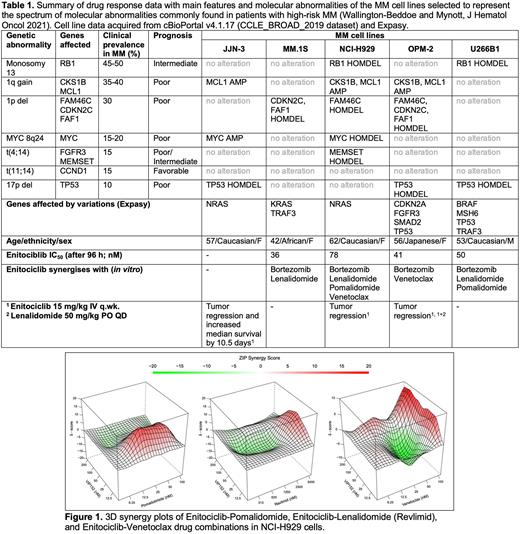Abstract
Background: Multiple Myeloma (MM) is a highly aggressive hematologic malignancy affecting plasma cells. Despite major advances in treatment, MM remains incurable and a significant proportion of patients experience disease progression or relapse. Studies have shown that cyclin D and MYC dysregulation and succeeding alterations in the apoptosis regulators are crucial in MM tumor cell survival and proliferation. CDK9, in complex with Cyclin T1, forms the positive transcription elongation factor, P-TEFb, that regulates RNA polymerase II (RNAPII) transcription initiation and elongation. RNAPII inhibition by CDK9 blockade leads to the disruption of transcription of MYC and other short half-life mRNA gene transcripts, providing durable control of oncogenic protein levels resulting in apoptosis and antitumor effects. The small-molecule inhibitor enitociclib (VIP152/formerly BAY1251152) that targets P-TEFb/CDK9 has shown effective molecular targetability and tolerability in preclinical and early phase clinical studies in other tumor models. Herein, we preclinically demonstrate the efficacy of enitociclib as a single-agent and in combination with several anti-MM agents.
Methods: Cell-based viability assays were performed in several MM cell lines NCI-H929, MM.1S, OPM-2 and U266B1 (Table 1). The antitumor activity was determined by Alamar Blue after 96 h of treatment. A panel of targeted small-molecule inhibitors (n = 223) at a final concentration of 1 µM was used to screen and identify potentially active agents and pathways. Combination screens of enitociclib with several anti-MM agents such as bortezomib, lenalidomide, pomalidomide and venetoclax were analyzed at constant dilution ratios of two inhibitors and drug synergy was calculated by the zero-interaction potency (ZIP) method using SynergyFinder 3.0 software (Figure 1). Target modulation by enitociclib as a single-agent or in combination was determined for RNAPII, MYC, MCL1, PCNA, cleaved pro-caspase-3 and PARP by western blotting after continuous exposure of the compounds for 24 h. In vivo enitociclib experiments were conducted using MM cell lines JJN-3, NCI-H929 and OPM-2 in SCID/Beige mouse xenograft models. Mechanism of action (MoA) was determined upon a single dose of 15 mg/kg enitociclib administered intravenously (IV), and efficacy on tumor growth and survival was examined following a dosing schedule of 15 mg/kg enitociclib administered IV every 7 days and in combination with 50 mg/kg lenalidomide given orally daily.
Results: First, the small-molecule inhibitor screening identified enitociclib as a highly active agent in MM cells. Subsequently, exposure to enitociclib for 96 h against a representative panel of MM cells (n = 4) demonstrated significant cytotoxic activity, with IC50 values ranging from 36 nM to 78 nM. SynergyFinder analysis detected synergistic effects of enitociclib with bortezomib, lenalidomide, pomalidomide and venetoclax (synergy scores >10) at pharmacologically relevant concentrations (Figure 1). Induction of apoptosis was observed with cleavage of pro-caspase-3 and PARP by western blotting in a dose-dependent manner with enitociclib as a single-agent and at a greater effect in combination with venetoclax. Dose-dependent depletion of phosphorylated serine 2/5 RNAPII, MYC, MCL1 and PCNA proteins were observed after 24 h exposure to enitociclib. In vivo, IV administration of enitociclib MoA transiently inhibits the transcription of MYC and MCL1 and promotes apoptosis by the induction of pro-caspase-3 and PARP cleavage with the onset of drug-induced effects as early as 1 hr after enitociclib treatment. In enitociclib-treated mice, tumor volumes were reduced to 1-4% that of control mice on day 20 after the start of treatment and enitociclib increased median survival time by up to 10.5 days. Increased efficacy of enitociclib in combination with lenalidomide was observed in vivo.
Conclusions: Our studies present the first proof-of-concept evidence that enitociclib has significant antitumor activity against several MM cell lines and provides specific pharmacological targetability of several key oncogenic pathways involving proteins such as MYC, MCL1 and PCNA, leading to growth inhibition and apoptosis. Taken together, the data provide the rationale and biological reasoning for further optimization studies of CDK9 inhibitors for clinical application to improve MM patient outcomes.
Disclosures
Johnson:Vincerx Pharma: Current Employment, Current equity holder in publicly-traded company; Janssen: Current equity holder in publicly-traded company, Ended employment in the past 24 months. Frigault:Vincerx Pharma: Current Employment, Current equity holder in publicly-traded company; Astra Zeneca: Current equity holder in publicly-traded company, Ended employment in the past 24 months. Izumi:Vincerx Pharma: Current Employment, Current equity holder in publicly-traded company; Astra Zeneca: Current equity holder in publicly-traded company, Ended employment in the past 24 months. Hamdy:Vincerx Pharma: Current Employment, Current equity holder in publicly-traded company; Astra Zeneca: Current equity holder in publicly-traded company, Ended employment in the past 24 months. Stelte-Ludwig:Vincerx Pharma GmbH: Current Employment, Current equity holder in publicly-traded company; Bayer: Current equity holder in publicly-traded company, Ended employment in the past 24 months. Bahlis:AbbVie, Amgen, Bristol Myers Squibb, Celgene, Forus, Janssen, Genentech, GSK, Karyopharm, Novartis, Pfizer, Takeda, Sanofi: Consultancy; Pfizer: Research Funding. Neri:Janssen: Consultancy, Honoraria; BMS: Consultancy, Honoraria; Sanofi-Aventis: Consultancy, Honoraria; Pfizer: Consultancy, Honoraria. Narendran:Provectus Biopharmaceuticals, Inc.: Consultancy, Research Funding; Vincerx Pharma, Inc.: Research Funding; CorMedix, Inc.: Consultancy, Research Funding.
Author notes
Asterisk with author names denotes non-ASH members.


This feature is available to Subscribers Only
Sign In or Create an Account Close Modal